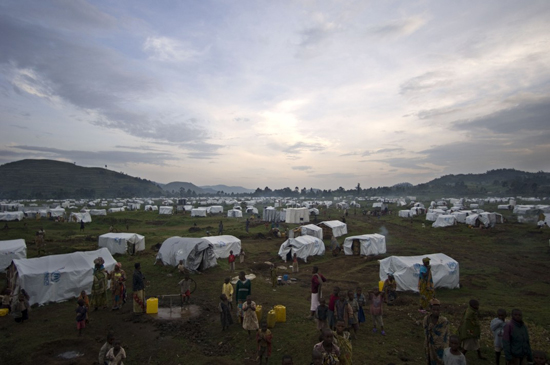In Uganda, MSF is providing aid to more than 25,000 refugees who fled violence in North Kivu, DRC.

Uganda July 2012 © Brigitte Rossotti/MSF
Congolese refugees arrive at a transit site in Bunagana, a town in the southwest of Uganda.
Since May, more than 25,000 refugees from the Democratic Republic of Congo (DRC) have crossed from DRC's North Kivu province into southwestern Uganda, fleeing clashes between the DRC’s army and rebel groups.
On July 4, fighting neared the border town of Bunagana and the flow of new arrivals intensified. Vincent, 30, is one of them. "We fled because we were frightened by the fighting between the army and the rebels,” he said. “There is an African proverb that says, 'When two elephants fight, the grass gets trampled.' I left the region of Rutshuru with my family to find safety in Uganda until things settle down."
Refugees are transported to the Nyakabande transit center on the outskirts of the town of Kisoro, which is usually a calm tourist hub near the Mufumbiro Mountains for travelers looking for the rare mountain gorillas.
Field News: 2008

Uganda 2007 © Vanessa Vick
Uganda: MSF Assists Refugees Escaping Violence in Eastern Congo
MSF has been working at the Congolese refugee camps in Kisoro since 2007.
Nyakabande transit center includes approximately 400 tents that have been set up in a huge field against the backdrop of the 13,500-foot-high Muhabura volcano. The population registered by the United Nations High Commissioner for Refugees (UNHCR) is now over 10,000, exceeding the site's initial capacity. Several humanitarian organizations, including Doctors Without Borders/Médecins sans Frontières (MSF), are providing shelter, water, food and health care to the refugees.
"The waves of new arrivals depend on where the fights are happening," says Brigitte Rossotti, MSF's operations coordinator on site. "Some people have walked for weeks to reach Uganda, hiding in the forest to avoid dangerous encounters. Others left in the morning and arrive in the afternoon.”
The refugees at Nyakabande also face the threat of cholera. An epidemic is already underway in the DRC, raising fears that cross-border movements could carry the disease into Uganda. Careful monitoring is required to identify any suspicious cases and contain the contagion before it spreads.
Some of the refugees at the site are waiting for the situation in DRC to stabilize before returning home. They worry about having to leave Nyakabande, which is normally used for transit only and is considered too close to the border by the Ugandan authorities.
Others have decided to settle in Uganda. Nearly 18,000 Congolese have thus been transferred to the permanent Rwamwanja site, an old refugee camp one day's travel from Kisoro that the Ugandan government reopened in mid-April. At the forested Rwamwanja site, each family receives supplies and a parcel of land to farm. Several NGOs are working to improve access to drinking water and health care.
"The current situation requires humanitarian presence at both sites—Nyakabande and Rwanwanja—simultaneously," says Ruben Pottier, MSF's head of mission in Uganda. "If refugees continue to arrive at this rate, more aid will be needed."
When fighting erupted between armed rebel groups and government forces in DRC in August 2007, tens of thousands of refugees began pouring over the border into Uganda. MSF helped set up transit sites along the border, including Nyakabande, and has been there working to provide health care to the steady flow of refugees ever since. Across MSF's projects on the Uganda-DRC border, staff provide services ranging from medical treatment for infections, malaria, and diarrhea to water and sanitation facilities.




